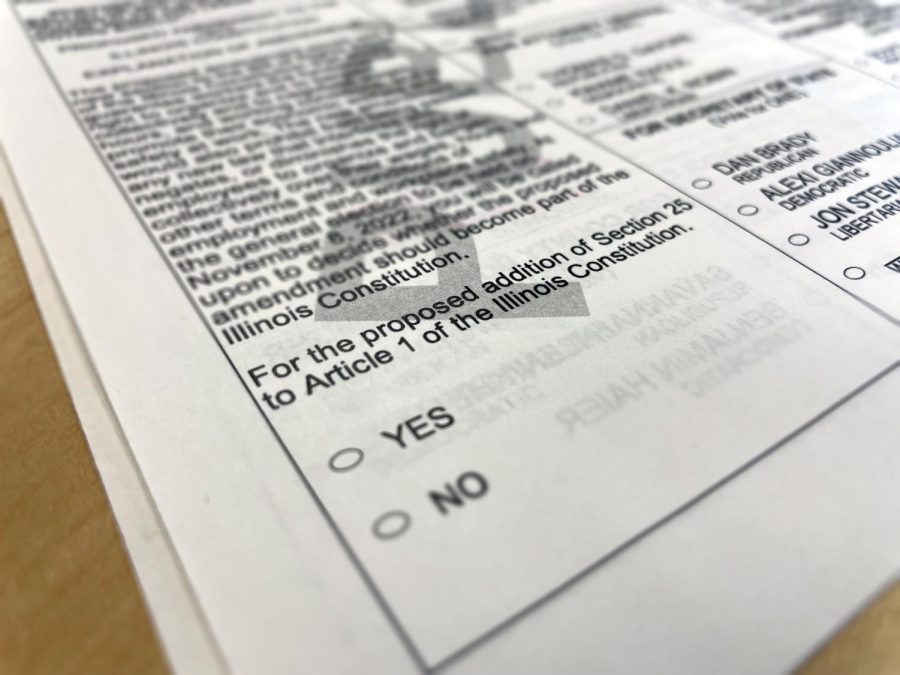Workers’ Rights Amendment passes in Illinois
The amendment received 58% of the vote on the Nov. 8 ballot
The Workers’ Rights Amendment appeared on the 2022 midterm ballot and passed with a majority vote.
November 15, 2022
DeKALB – Amendment 1, or the Workers’ Rights Amendment, passed on Nov. 14 with 58% of the vote, making Illinois the fourth state, along with Hawaii, Missouri and New York, to ensure the right to collective bargaining in its constitution and the first to ban right-to-work or laws that interfere, negate or diminish the right of employees to unionize.
The Workers’ Rights Amendment will amend the Illinois constitution to give workers the fundamental right to organize and bargain collectively through unions for the purpose of negotiating wages, hours and working conditions.
According to the International Union of Painters and Allied Trades, in states with right-to-work laws, workers make 12.2% less annually than workers in other states because unions in those states don’t have the power to fight for better wages. Poverty rates are 14.8% higher in states with right-to-work laws because of the lower income. Illinois is now the first state in the U.S. to ban right-to-work laws completely, according to Ballotpedia.
“Right-to-work laws usually correlate with lower wages, less benefits or poverty,” said Tyler Rambuski-Salzman, a junior pursuing a degree in political science and the president of NIU’s chapter of the Young Democratic Socialists of America. “So, the fact that Illinois is rejecting that (right-to-work laws) – and it’s gonna be very difficult in the future to repeal this amendment – so, if there is an anti-worker governor or legislature comes to power, it’s gonna be very, very difficult for them to overturn this.”
Andy Bruno, an associate professor of history and director of graduate studies at NIU, expressed his satisfaction with the amendment and its passing.
“I was excited that it passed,” Bruno said. “I think it is important to get labor protection enshrined in the state constitution, and I think it is part of a larger movement to build back the labor movement after quite a while of it being weakened.”
The right to unionize has always been a federal right, but now it will be a right at the state level as well.
Amendment 1 is strongly tied to the history of workers’ rights in Illinois and the nation. On July 6, 1935, the Wagner Act was signed into national law and secured the federal right of employees to join or create unions. It required employers to bargain collectively with any union selected by most employees in an appropriate bargaining unit through the National Labor Relations Board.
“In the 1930s, most workers, at a federal level, gained the right to organize and bargain collectively for the first time,” said Rosemary Feurer, an associate professor of history at NIU who specializes in labor movements. “The United States was a late bloomer in that regard among industrial nations.”
In 1947, the Taft-Hartley Act challenged these rights and modified the Wagner Act. This modification gave workers the right to deny joining and paying to be in a union, but this created new issues.
“With the Wagner Act, the practice had been – once you had a union democratically voted on, the federal government forced the employer to recognize it, and that meant that if the majority of workers passed it, everybody would be obliged to join or pay dues,” Feurer said. “What they (Robert Taft and Fred Hartly) did was say, ‘Well, you can tell workers that they don’t have to pay dues but still be represented by the union,’ so it forced the union to represent people who may not have been paying dues.”
The Taft-Hartley Act made it so that unions would still represent people who weren’t due-paying members. In the same way people must pay taxes to keep society running, unions rely on dues from members to protect employees by negotiating contracts and defending workers through the legal system.
Laws that took inspiration from the Taft-Hartley Act began to show up at the state level soon after 1947. These state laws that keep unions from requiring members to pay dues are known as right-to-work laws.
“It’s a clever term, right-to-work,” Feurer said. “The goal of the right-to-work is to restrict workers’ power by using that term. They say, ‘you have the right not to pay dues,’ but if you look who’s pushing it, you can very clearly see that it’s people with power and money pushing those laws.”



